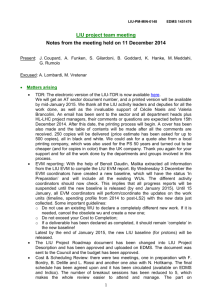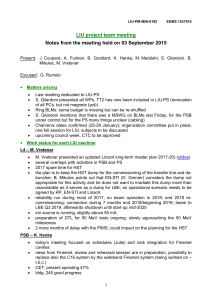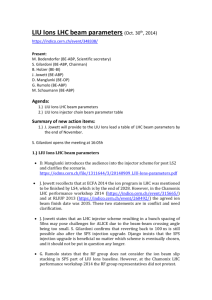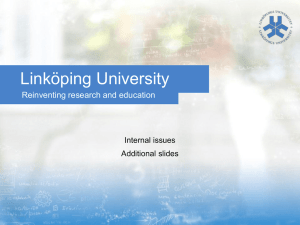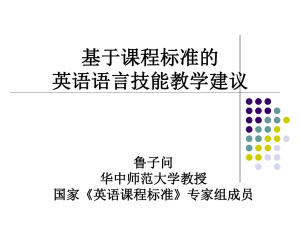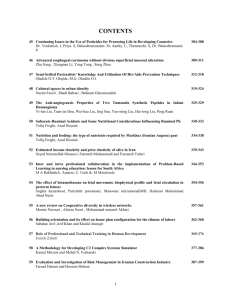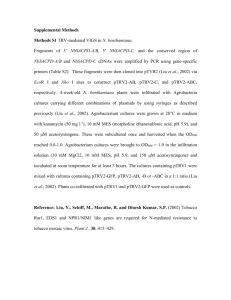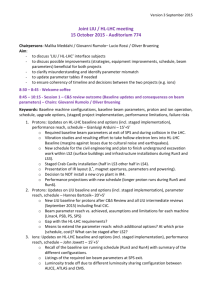Chamonix14_session8_jcoupard - Indico
advertisement
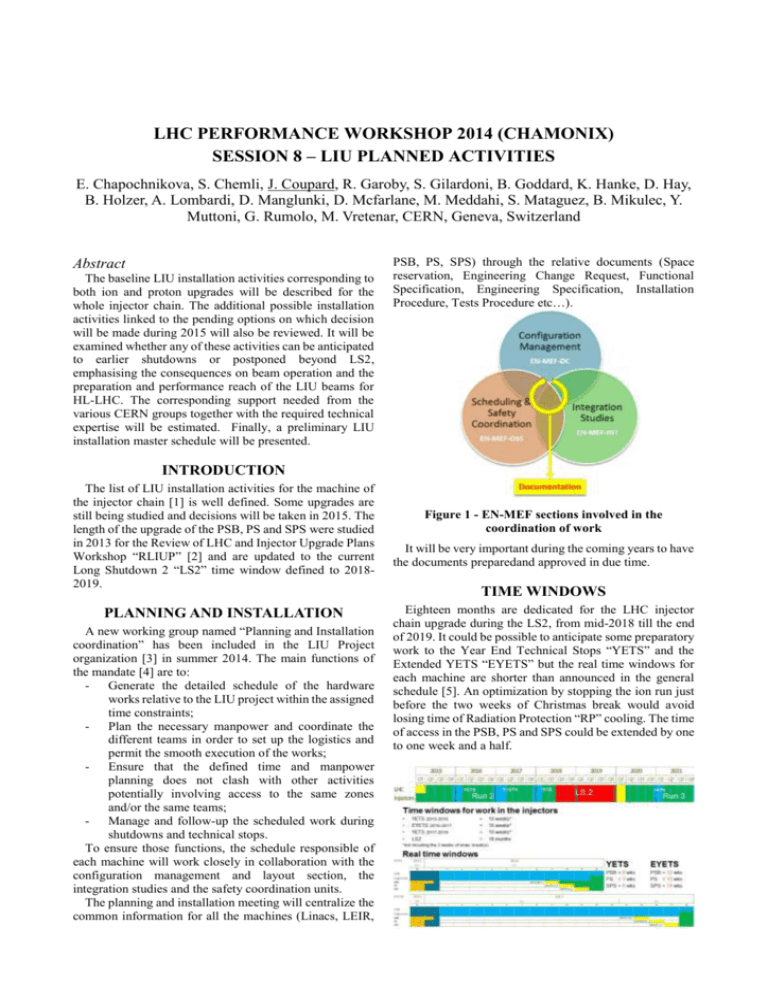
LHC PERFORMANCE WORKSHOP 2014 (CHAMONIX) SESSION 8 – LIU PLANNED ACTIVITIES E. Chapochnikova, S. Chemli, J. Coupard, R. Garoby, S. Gilardoni, B. Goddard, K. Hanke, D. Hay, B. Holzer, A. Lombardi, D. Manglunki, D. Mcfarlane, M. Meddahi, S. Mataguez, B. Mikulec, Y. Muttoni, G. Rumolo, M. Vretenar, CERN, Geneva, Switzerland Abstract The baseline LIU installation activities corresponding to both ion and proton upgrades will be described for the whole injector chain. The additional possible installation activities linked to the pending options on which decision will be made during 2015 will also be reviewed. It will be examined whether any of these activities can be anticipated to earlier shutdowns or postponed beyond LS2, emphasising the consequences on beam operation and the preparation and performance reach of the LIU beams for HL-LHC. The corresponding support needed from the various CERN groups together with the required technical expertise will be estimated. Finally, a preliminary LIU installation master schedule will be presented. PSB, PS, SPS) through the relative documents (Space reservation, Engineering Change Request, Functional Specification, Engineering Specification, Installation Procedure, Tests Procedure etc…). INTRODUCTION The list of LIU installation activities for the machine of the injector chain [1] is well defined. Some upgrades are still being studied and decisions will be taken in 2015. The length of the upgrade of the PSB, PS and SPS were studied in 2013 for the Review of LHC and Injector Upgrade Plans Workshop “RLIUP” [2] and are updated to the current Long Shutdown 2 “LS2” time window defined to 20182019. PLANNING AND INSTALLATION A new working group named “Planning and Installation coordination” has been included in the LIU Project organization [3] in summer 2014. The main functions of the mandate [4] are to: - Generate the detailed schedule of the hardware works relative to the LIU project within the assigned time constraints; - Plan the necessary manpower and coordinate the different teams in order to set up the logistics and permit the smooth execution of the works; - Ensure that the defined time and manpower planning does not clash with other activities potentially involving access to the same zones and/or the same teams; - Manage and follow-up the scheduled work during shutdowns and technical stops. To ensure those functions, the schedule responsible of each machine will work closely in collaboration with the configuration management and layout section, the integration studies and the safety coordination units. The planning and installation meeting will centralize the common information for all the machines (Linacs, LEIR, Figure 1 - EN-MEF sections involved in the coordination of work It will be very important during the coming years to have the documents preparedand approved in due time. TIME WINDOWS Eighteen months are dedicated for the LHC injector chain upgrade during the LS2, from mid-2018 till the end of 2019. It could be possible to anticipate some preparatory work to the Year End Technical Stops “YETS” and the Extended YETS “EYETS” but the real time windows for each machine are shorter than announced in the general schedule [5]. An optimization by stopping the ion run just before the two weeks of Christmas break would avoid losing time of Radiation Protection “RP” cooling. The time of access in the PSB, PS and SPS could be extended by one to one week and a half. Figure 2 - time window for stops from LS1 to LS2 PSB PLANNED ACTIVITIES As described in the Technical Design Review “TDR” [6], the LIU-PSB project can be divided in two upgrade projects, which could either be implemented simultaneously or in two phases: the modification of the Booster injection (BI) line and injection region for 160 MeV H- injection, and the energy upgrade of the Booster rings and extraction including the transfer line to the PS to 2 GeV. The modifications of the injection region cover the part of the Linac4-PSB transfer line downstream of the concrete wall which separates the Linac and PSB access zones (downstream of BI.QNO20). The part of the transfer line upstream of this wall falls into the Linac4 project. The LIU-PSB project therefore comprises the modifications of most of the BI line as well as the modifications in the injection period of the PSB (periods 1/16). This includes the beam separation scheme (distributor and vertical septum), as well as the stripping foil and painting hardware and other modifications associated with this. Figure 3 - PSB draft schedule for LIU Project during LS2 One month and a half are needed for RP cooling before going underground. Fifteen months of work are estimated, taking into account three shifts for more than nine months of cabling activities, and hardware commissioning. There will be three months of beam commissioning of the PSB, after the complete modification of the machine. Half sector test According to the Linac4 Master plan [7] reviewed in August 2014, the half sector test will be performed in 2016. The end of those tests is foreseen for August 2016. PS PLANNED ACTIVITIES The role of the PS in the production of the beams for the LHC, as defined in the TDR [6], is to preserve at maximum the transverse emittances defined by its injector, the PS Booster (PSB), and to manipulate the longitudinal phasespace to define the bunch spacing required by the collider. For the production of the future HL-LHC type beam, major upgrades are needed to eliminate the existing limitations, in particular related to space-charge and longitudinal instabilities. Figure 4 - PS draft schedule for LIU Project during LS2 The RP cooling time before accessing into the PS is shorter than for the PSB. The underground will stay closed during one month and thirteen months are then needed for the upgrade and consolidation of the magnets, which is not part of the LIU Project. One month and a half will be added for the hardware commissioning and cold check-out, before finishing with one month and a half of beam commissioning. SPS PLANNED ACTIVITIES The TDR [6] mentions that for the SPS, the main limitations come from the beam-loading at very high beam intensity, which reduces the RF voltage available; longitudinal instabilities linked to the longitudinal impedance; the electron cloud effect, which at 25 ns can make operation impossible through high vacuum or instabilities; and the high stored beam energy which requires significant upgrades of all beam intercepting protection devices in the ring and transfer lines. The instrumentation requires major changes to be able to reliably characterise the very bright beams, and changes to other systems like the magnet interlocking and vacuum sectorisation are designed to improve availability. Figure 5 - SPS draft schedule for LIU Project during LS2 Some of the upgrade activities have been done during the LS1. The remaining interventions request at least ten months of work and two months and a half for the hardware commissioning. The beam commissioning of the SPS is estimated to one month and a half. IONS ACTIVITIES In order to increase the peak luminosity requested by the ALICE experiment for the HL-LHC era, it has been decided, as explained in the TDR [6], to increase the number of bunches in the collider. So that, the following upgrades are planned: Implementing new optics in the Low Energy Beam Transport (LEBT) Increasing the repetition rate of Linac3 to 10 Hz (“100 ms operation”) Lifting or mitigating the LEIR intensity limitation Reintroducing the bunch splitting in the PS Installing a new ion injection system in the SPS, with a 100 ns rise time SPS momentum slip stacking The upgrades are located inside the machine Linac3, LEIR and the SPS. No more than six months are needed for all modifications. The major work concerns the 100 ns rise time kickers in the SPS and the modification of the LBS measurement line. CONNECTION OF THE LINAC4 The Linac4 will be operated for reliability run from 2016. The major works to be carried out for the connection of the Linac4 to the transfer line going to the PSB are The dismantling of the HST Completion of the transfer line with installation of the debuncher Change of the BHZ20 Modification of civil engineering and access Modification of the LBE measurement line Three months of intervention will be needed for the connection. These activities must be done at the appropriate time, in order to fit with the workload and resource levelling in the other machines. MASTER SCHEDULE The preliminary master schedule of the LIU Project compiles all draft schedules of the machines of the injector chain. The phases are identified as RP cooling, underground activities, hardware commissioning and beam commissioning. Figure 6 - master schedule of the LIU Project The PSB upgrade and the commissioning of the whole injector chain is clearly on the critical path. The work organization and resource levelling will be challenging for LS2. CONCLUSION All work activities listed in the scope of the LIU fit in the LS2 time window defined for the injector chain but the schedules are very tight. There are no contingency and the cabling activities are already foreseen to be carried out in shifts for the PSB. The decisions on non-priority consolidation works have to take into account the LIU activities. To complete the schedule analysis and organization of the work, additional studies have to be done: - All new cabling requests “DIC” need to be made as early as possible in order to estimate the EN/EL workload and integration. - Evaluation of manpower usage in all CERN complex (Injectors, LHC, Experiments), mainly for contributing groups : EN/MME, EN/HE, EN/CV, EN/EL, EN/MEF-SU, GS/SE, TE/VSC - Design and production plan to be defined in order to match the schedules of installation - Integration studies to be completed (3D models of infrastructures, general services) - Definition of all works that can be anticipated in YETS and EYETS in order to reduce the workload for LS2 (i.e. dismantling, decabling …) REFERENCES [1] LIU Upgrade work activities, LIU-PM-NOT-0013, EDMS 1296785 [2] Review of LHC and Injector Upgrade Plans Workshop (RLIUP), 29th – 31st October 2013, Indico link [3] LIU Project organization chart, LIU-PM-PP-0030, EDMS 1403771 [4] Technical Coordinator of the LHC Injectors Upgrade Project Mandate, LIU-PM-QA-0011, EDMS 1410283 [5] LHC schedule beyond the LS1, EDMS 1342322 [6] Technical Design Review of the LIU-Project [7] Linac4 Master Plan, EDMS 1419460
